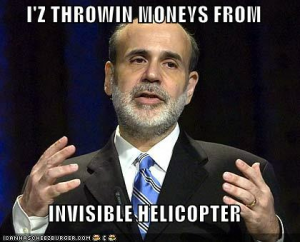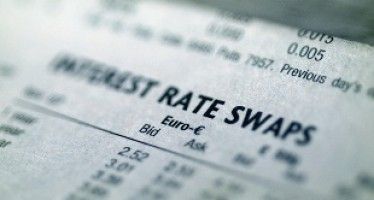Bernanke’s QE3 slamming California economy
By Wayne Lusvardi
Those desperately in search of a cure for cancer will often try apricot pits bought in Mexico, exotic herbs or light therapy treatments. None has been proven to be effective.
In an action with direct implications for California, the Federal Reserve Bank is conducting a third desperate round of “quantitative easing” as the therapy of last resort, what it’s calling QE3.
Quantitative easing is a sophisticated indirect way to print more money without having to use a printing press. This process was once described as similar to dropping dollar bills from a helicopter by no less than Ben Bernanke, the Fed’s chairman. Thus his nickname, Helicopter Ben.
Wise voters know that any nostrum or treatment peddled right before an election is often likely to be snake oil.
QE3 is hospice care for the terminal debt crisis. It will get money flowing around the economy when the conventional economic stimulus method of cutting interest rates no longer works because the Fed already cut interest rates close to zero, and so can’t cut them any more.
Quantitative easing magically creates new money. The Fed just increases the size of the accounts of in its member banks. It then buys mortgage assets of banks so that the banks have more money to put into circulation.
Ben’s QE3 a boom for Bakersfield and Berkeley….
QE3 will push up the price of any commodity, whether it is houses, gold, food, or oil. By weakening the purchasing power of the dollar, it boosts demand for hard financial assets and essential goods.
This means that communities in oil rich Kern County are experiencing a boom. Bakersfield is already reported to be experiencing an economic “recovery” because of QE1, QE2, and now QE3, which is already four months old.
It also pumps up demand for housing with near-zero interest rates and escalating home prices occurring at the same time. Bakersfield home prices are up 7.0 percent since last year. The 30-year mortgage rate for Freddie Mac was 3.55 percent last week, with monetary inflation for the past year running 2.4 percent. The effective mortgage rate after inflation is about 1 percent. But after QE3, it may be a net zero percent, which is effectively free money.
According to Ruchir Sharma of Morgan Stanley Bank, in 2009 the lowest income groups had to spend 41 percent of their after-tax income on gasoline and food, with little money left over for luxuries. Conversely, the top income brackets spent only 2 percent of their incomes on gasoline alone, which was only 25 percent of what the poorest income bracket spent. All that QE1 and QE2 did was boost the stock market, which benefited the wealthiest 10 percent of the population that hold 75 percent of all common stocks.
This means that wealthy communities along the California coastline, such as Berkeley, are likely to be less damaged by the effects of QE3. And cities like Berkeley have a higher percentage of homes with built-up equity that can be used to downsize into more affordable housing or serve as collateral for small business loans.
Those who have an oil-related economic base, like Bakersfield, and a low percentage of underwater mortgages and trust fund wealth like Berkeley are able to weather the storm of inflation better.
… and a bust for San Bernardino …
Even though home prices are also up 7.0 percent in San Bernardino, the effect of high gasoline and food prices from QE3 will make it hard for a housing recovery without an accompanying increase in jobs and incomes. San Bernardino County doesn’t have the oil jobs boom that Kern Count does. And it has a high percentage of home foreclosures and underwater mortgages.
All that QE3 will likely do in places like San Bernardino is penetrate through the inflated price of housing and stocks to higher prices for gasoline and essential goods. This will result in less money to save up a down payment for a home.
According to Richard Green, director of the U.S.C. Lusk Center of Real Estate, “The constraint that is keeping people out of the housing market is absence of equity [down payment]. The drop in house prices means that many borrowers are underwater on their houses, and high unemployment has prevented potential first-time buyers from accumulating down payments.”
… as well as a bust for Gov. Brown’s Tax Increase Proposition
Sharma also said, “Inflated prices for commodities like oil carry the seeds of their own destruction, because the higher they rise, the more likely they are to stall the economy.”
Sharma reported that speculators are betting on QE3 diluting the dollar and driving up oil prices, thus putting the United States right back into another economic recession in 2013.
More inflation of gasoline and essential goods may spell doom for Brown’s Proposition 30 tax increase proposal on the November ballot. Prop. 30 mainly would hit taxpayers making $250,000 or more a year. But voters aren’t likely to vote for a tax increase that doesn’t reduce their higher gasoline and foods costs and provides new private sector jobs.
As economist Michael S. Rozeff noted, QE3 is driving up government bond rates and the cost of government borrowing: Higher government bond yields are “a far larger negative to the government than any minuscule decline in mortgage yields” from lower interest rates or QE3-induced inflation.
QE3 is a treatment for the debt cancer that continues to spread in California. But it would only make the bottom-line economy worse for most households.
Politicians should be reminded that those afflicted with the QE3 debt cancer will still vote with their pocketbooks and don’t want political placebos.
(Editor’s note: The paragraphs in boldface were corrected from earlier versions.)
Related Articles
Greece as preview for California
MAY 3, 2010 By CHRISS STREET Californians should pay close attention to the painful consequences to the Greeks from the
Moody's Views of Brown's SOS Speech
FEB. 1, 2011 By WAYNE LUSVARDI In a press release dated Jan. 27, Moody’s credit-rating agency began adding unfunded public
After gamble backfires, L.A. demands refund from banks
In the San Francisco Bay area, public transit riders are paying $104 million in higher rider fees to cover




